|
Another puzzling photo received from Tom
Cosens from Yorkshire
(UK)
of an old car
he didn't recognise. This is from his collection of postcard
curiosities on which he has no other background, but which are needing
identification.
Really lovely photo of a three level mall 'sightseeing bus'.
Solid roof, beautifully built coachwork body and not a charabanc. Seems like a cca 1910 Benz but not quite.
Chain Drive, multiple wheelnuts at back and front. It also does not match
Daimler-Mercedes either.
Looks like a 'works outing' and seems to have been posed in front of the
Polsen Silversmiths shop somewhere in Germany. All the signs are German. Perhaps finding out the location of
the Polsen Shop may
help in determining the town of manufacture of the vehicle. We thought
it may be interesting to make a note of all the avenues of explorations
that are needed and encountered in trying to resolve such an enquiry
which comes to us with no background to help.
The shop in background has a hording advising : " L Polsen Wwe,
Silberwaaren-Fabrik". Quite a bit of digging established that there had
been a company in Frankfurt started by a man called Lazarus Polsen.
"The firm was founded in Frankfurt-am-Main in 1869 by Brendina
Wetzlar, the widow of Lazarus Jacob Posen, a silversmith and retailer of
Polish descent. Under the widow Posen's stewardship, the firm became the
largest supplier of Judaica in the late 19th century. ……They
received a royal warrant in 1903 and opened a second shop in Berlin. …..
In the 20th century the firm was under the direction of Brendina's
grandsons Jakob, Hermann and Moritz Posen. The exact date of the
company's closure is not known, but it seems certain that the wealthy
Jewish-owned firm was a victim of the terrors of the Nazi regime."
 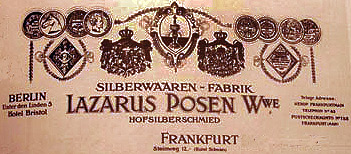
Having two possible locations, it became necessary to determine which shop is in
the photo. Careful study of the photograph shows it was next to a
"Bristol Restaurant". Study of the Posen visiting card above suggests that the Berlin shop was part of the Bristol Hotel in Berlin,
so the photo would be Berlin, in the famous street 'Unter den Linden'.
The street was originally developed as an equestrian path by John George
of Brandenburg in the 1500s. He needed an easy way and direct route to
reach his hunting grounds that were located in Tiergarten. Eventually
linden trees were planted to adorn the length of the street, and extended to reach the city gates from the palace. The street is now a
broad boulevard in the central Mitte district of Berlin from the City
Palace to the Brandenburg Gate. Linden trees that line the grassed
pedestrian mall are a variety of lime trees.
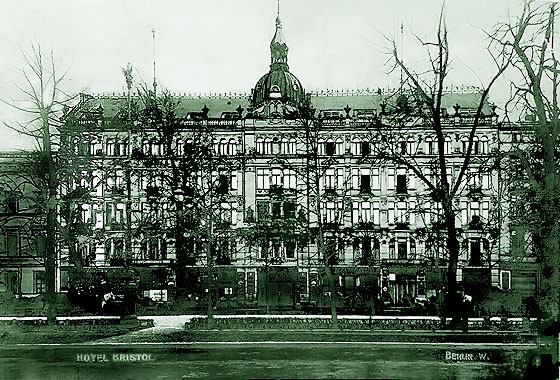
Hotel Bristol was designed by architect Gustav Georg Carl Gause and
opened in 1891, - and was totally destroyed on
15 February 1944 when the hotel was demolished during an air raid
on Berlin. In its early days the hotel's bar was popular with wealthy young naval
officers especially during the First World War. Incidentally researches
also advise that on "September 30,
1897, the first German automobile exhibition took place in the heart of
Berlin. Eight resplendently polished motor coaches stood on the
boulevard Unter den Linden in front of the posh Hotel Bristol. The
occasion was the founding meeting of the Central European Motor Car
Association, followed by a drive through the Grunewald forest."
On some of the photographs of the Hotel Bristol it is possible to see that the
front of the whole ground floor was separate individual shops and that the Posen
shop was the last two bays on the right. The address of Hotel Bristol was
Unter den Linden No 5/6. After much in depth research it was not possible to
link that
the the vehicle in the top photo had anything nothing to do with the Posen company,
although it did help to lead us to where the photo was taken!
 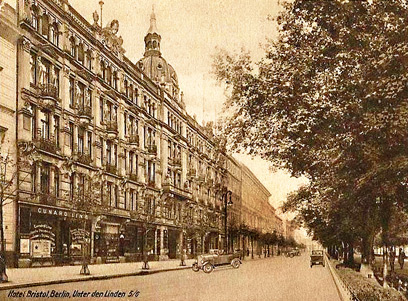
Although the location of the photo was now known, we were no further on the
identification of the vehicle. In some respects it had the look of a Benz and
also the look of a Daimler Mercedes. In those days the two makes were serious
competitors and did not come together until a much later 1926. As the
vehicle was likely cca 1908, there was only a limited number of German manufacturers
who were into making bigger multi-seat tourers and/or commercial vehicles
So we contacted our 'veterans expert' Ariejan Bos in
Holland with all of the above information and he suggested that the vehicle
may have been used by Weltreise Union. who were 'travel agents' based in Berlin.
Further research determined that the Weltreise Union had a shop in Unter Den
Linden, variously described as 5/6 or 7/8. It seems they had the Thomas Cook agency
and the agency for North German Lloyd. Either way it seems the shop was next
door to the Posen shop and that is why it is probably in the background of this
photo. Photo below shows the Weltreisebureau Union premises with a
slightly later Touring Bus just having embarked passengers for a 'Round
Town' tour.
 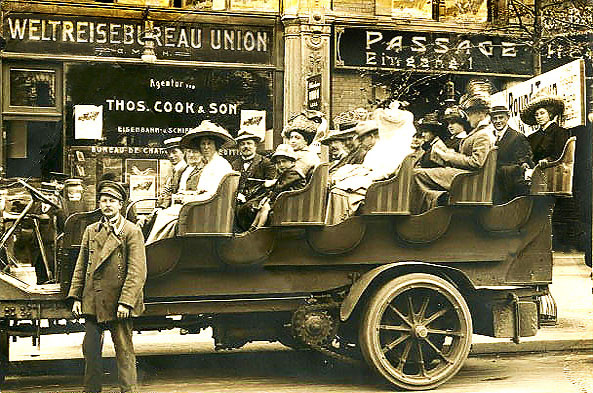
Ariejan Bos also advised that he has a number of
photos of vehicles being used by Weltreise Union in previous and subsequent
years for tours of Berlin and the surrounding areas. It seems that obe of the
regular operators were Wellroth Auto-Fahrt Geselldchaft. Many of these
were charabancs of differing sizes and many of then were of the NAG make. Main
reason that Nag was popular was presumably because NAG Vehicles were made only a
couple of miles down the road in the nearby suburb of Oberschoneweide.
 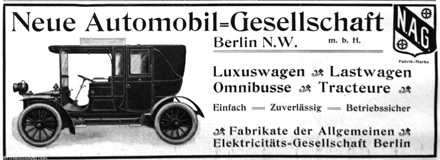
'Neue Automobil-Gesellschaft' was founded in 1901 by the Electrical Company AEG
buying the Kühlstein coachbuilders and renaming it NAG. In 1915 it was again
renamed Nationale Automobil Gesellschaft , remaining known as NAG.. They made
sturdy basic cars much on the principle of the contemporary Daimler Mercedes.
Some of their vehicles were big and had very powerful engines (7.9L in 1907).
They carried on with cars until closing in 1937, but they began very early on to
expand into coaches and busses, and into commercial vehicles. They became for a
while one of Germany's biggest vehicle manufacturers. The closed coach below was
available as early as 1906. Most of the early Sightseeing Busses were roofless
Charabancs, and quite basic.
 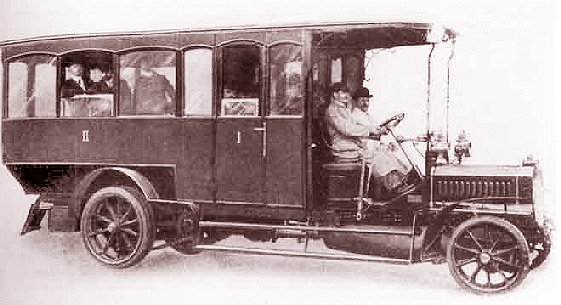
Ariejan suggests that our mystery vehicle is very likely a NAG being used by Weltreisebüro Union,
It looks like being one of a fleet of such vehicles, this one being No 4 , Each
vehicle was capable of carrying nine passengers in the rear cabin in potentially
weatherproof luxury and having three tiers for better vision, with a room for
three at the front in the rain. The bonnet is slightly unusual but as the
vehicle is coach-built, this may have extended to the bonnet. It does however
have the identification features of cup handles for lifting the bonnet and has
multiple hubnuts which are both features of a NAG. The other feature which could
have confirmed NAG is the oval shape of the radiator, but this is not visible as
the car is fully side-on, unlike on the photo above.

Go to Recent Venues
Page
PICTURE GALLERY INDEX
|







